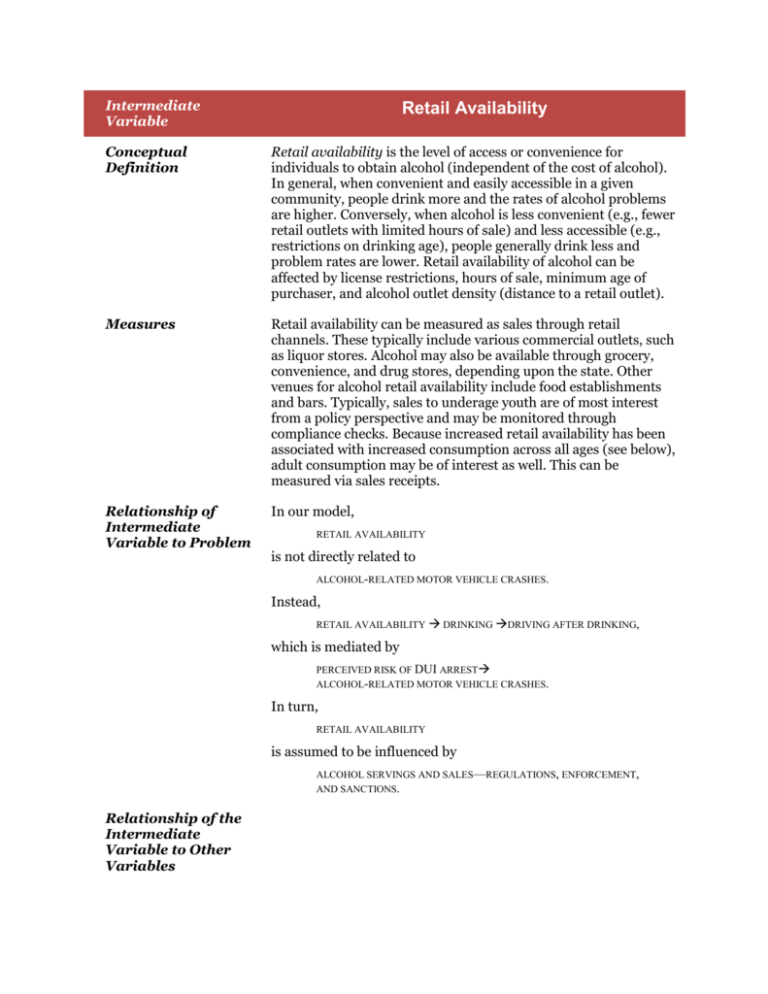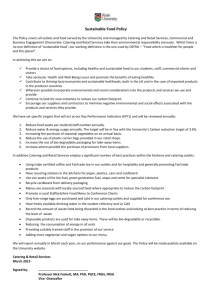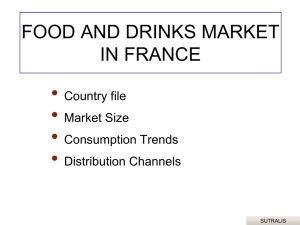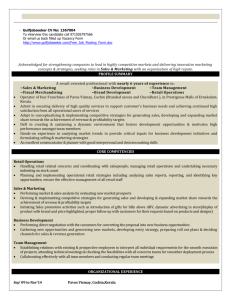Retail Availability - Prevention Research Center
advertisement

Intermediate Variable Retail Availability Conceptual Definition Retail availability is the level of access or convenience for individuals to obtain alcohol (independent of the cost of alcohol). In general, when convenient and easily accessible in a given community, people drink more and the rates of alcohol problems are higher. Conversely, when alcohol is less convenient (e.g., fewer retail outlets with limited hours of sale) and less accessible (e.g., restrictions on drinking age), people generally drink less and problem rates are lower. Retail availability of alcohol can be affected by license restrictions, hours of sale, minimum age of purchaser, and alcohol outlet density (distance to a retail outlet). Measures Retail availability can be measured as sales through retail channels. These typically include various commercial outlets, such as liquor stores. Alcohol may also be available through grocery, convenience, and drug stores, depending upon the state. Other venues for alcohol retail availability include food establishments and bars. Typically, sales to underage youth are of most interest from a policy perspective and may be monitored through compliance checks. Because increased retail availability has been associated with increased consumption across all ages (see below), adult consumption may be of interest as well. This can be measured via sales receipts. Relationship of Intermediate Variable to Problem In our model, RETAIL AVAILABILITY is not directly related to ALCOHOL-RELATED MOTOR VEHICLE CRASHES. Instead, RETAIL AVAILABILITY DRINKING DRIVING AFTER DRINKING, which is mediated by PERCEIVED RISK OF DUI ARREST ALCOHOL-RELATED MOTOR VEHICLE CRASHES. In turn, RETAIL AVAILABILITY is assumed to be influenced by ALCOHOL SERVINGS AND SALES—REGULATIONS, ENFORCEMENT, AND SANCTIONS. Relationship of the Intermediate Variable to Other Variables Retail Availability to Drinking The retail markets for alcohol can be formal or informal. Formal alcohol markets can be defined as those that are regulated by government, whether at the community, the regional, or the national level. In developed countries, formal retail markets for alcohol (like most commodities) are regulated to ensure purity, safety, and accurate description of the product and the collection of taxes. Some countries also have special sales regulations for alcoholic beverages, reflecting their status as a commodity that raises special concerns about health, safety, and public order. Thus, retail outlets for the sale of alcoholic products may have general limits on hours of operation or days allowed for retail services and the placement and location of the retail market. Further, restrictions may be placed on advertising and marketing of the alcoholic products and on who may purchase the products. Special taxes on alcoholic beverages may also be part of the regulatory regime. Restricting alcohol availability through law has been a key policy in Canada, the United States, and Scandinavian countries. Restrictions on retail availability are intended to limit consumer access to products or to regulate the context in which products are used. Most availability policies, however, do not restrict access altogether; rather, they serve to increase the effort required to obtain substances or change the context in which consumption occurs, thus changing consumption practices. In general, research concerning restrictions or limits on retail availability of alcohol has demonstrated overall effects on the general population’s level of consumption and alcohol-related problems. Gruenewald et al. (1996) completed an analysis of geographically based data from four communities conducted to evaluate relationships between measures of the physical availability of alcohol and rates of driving after drinking. From a review of the literature, it was expected that rates of driving after drinking would be directly related to the availability of alcohol at on-premise establishments. Based on theoretical arguments regarding the life activities that underlie drinking and driving, it was expected that the effects of availability upon these outcomes would extend significantly beyond local area outlets. Taking into account the geographic variations in environmental characteristics (road network density, traffic flow, population density), and socioeconomic (age, gender, race, marital status, income, employment) and drinking characteristics (rates of abstention, frequency and quantity of use) of resident populations, a spatial analysis of drinking-and-driving and alcohol-related crashes was conducted. The results of the analysis showed that physical availability was unrelated to selfreports of driving after drinking and driving while intoxicated and significantly related to rates of SVN crashes. In the latter case, physical availability affected both local and adjacent area rates of crashes. Several longitudinal studies have demonstrated that changes in the number of outlets are related to changes in alcohol use. When overall availability is low, the addition of a few outlets can have noticeable effects on drinking. Gruenewald, Ponicki, and Holder (1993b) conducted a time-series cross-sectional analysis of alcohol consumption and density of alcohol outlets across 50 U.S. states. The results suggested that a 10% reduction in the density of alcohol outlets would reduce consumption of spirits from 1 to 3% and consumption of wine by 4%. The evidence is quite strong that these systems hold down rates of alcohol consumption and alcohol-related problems. For example, alcohol retail monopolies are associated with lower levels of alcohol-related motor vehicles. The evidence suggests that elimination of government off-premise monopolies typically increase total alcohol consumption. Thus, large-scale changes in alcohol distribution systems among states in the United States have led to great increases in the number of alcohol outlets (e.g., through the privatization of alcohol monopolies resulting in increased alcohol sales; Holder & Wagenaar, 1990; Wagenaar & Holder, 1995). A summary of seven time-series analyses of six U.S. states and of New Zealand showed a consistent increase in total consumption when government-owned off-premise outlets were replaced with privately owned outlets (Wagenaar & Holder, 1996). Several studies show substantial long-term increases in alcohol sales following privatization (Holder & Wagenaar, 1990; Wagenaar & Holder, 1991, 1995), although others only found short-term increases (Mulford, Ledolter, & Fitzgerald, 1992). Until effects of such privatization are fully evaluated, states should consider preventing privatization because reversal of the privatization process is not politically feasible. Typically, the network of stores in such a government-operated system is sparse rather than dense, and the opening hours are limited. A variety of alcohol-related problems are more likely to occur where drinking places are clustered. These include motor vehicle crashes (Watts & Rabow, 1983; Rush, Gliksman, & Brook, 1986; Scribner, MacKinnon, & Dwyer, 1995; Jewell & Brown, 1995; Gruenewald et al., 1996) and pedestrian injury collisions (LaScala, Gerber, & Gruenewald, 2000; LaScala, Johnson, & Gruenewald, 2001). Findings have shown that alcohol-related problems respond to alterations in the availability of alcohol (e.g., measures of abuse [Chiu, Perez, & Parker, 1997] and motor vehicle crashes [Blose & Holder, 1987]). Strategies Types of Retail Studies of alcohol regulations suggests that restrictions on the physical availability of alcohol, including retail availability, can contribute to the reduction of alcohol-related problems. Specific effective policies include reductions in the hours and days of sale and the number of alcohol outlets, as well as restrictions on access to alcohol (Babor, et al, 2003) Whether in a formal or an informal market, alcoholic beverages Outlets are sold to retail customers in two forms. One form is for consumption elsewhere (off-premise); this form influences drinking, the drinking occasion, and the potential consequences through the conditions of sale. This effect generally stops at the point when the sale is made. The opportunities to affect these offpremise retail outlets are thus limited to regulations on the time, costs, and place of alcohol sales. The other form in which alcoholic beverages are sold is as drinks served in glasses or other drinking vessels, with the actual consumption usually occurring on or about the premises where the drink is served. These are typically called “on-premise” retail outlets. Here, the opportunities to influence drinking—its context and its potential consequences—are broader, as there is an opportunity to directly influence what happens during and after the actual purchase. Regulations may specify drink sizes, disallow discounted drinks such as during “happy hours,” and include requirements for responsible beverage service training, programs to provide “safe rides” for drinking drivers, and so on. Regulations may also apply to the design and furnishing of the tavern or restaurant, food service, availability of entertainment, and other non-alcohol-specific matters. For off-premise outlets, a major policy decision has been whether (and which kinds of) alcoholic beverages can be sold in conjunction with other goods, and which other goods. When Finland changed in 1968 from selling beer only in government monopoly stores to selling it also in grocery stores, alcohol consumption rose by 50% in the next year, and alcohol problem rates also shot up (Bruun, Edwards, & Lumio, 1975). As Abbey, Scott, and Smith (1993) have shown, this practical impediment can be easily overcome if purchases of alcohol are combined with other routine life activities (e.g., shopping for other goods). Regulation of on-premise alcohol outlets has a rich and detailed history in many societies. Within the on-premise category, restaurants are often differentiated from taverns, according to whether food or drinking is the primary activity. Cross-sectional studies have found that drinking and driving is associated with bars and restaurants and particularly (in Australia) with bars serving beverages with high alcohol content (Gruenewald, Stockwell, Beel, & Dyskin, 1999; Gruenewald, Millar, Ponicki, & Brinkley, 2000; Stockwell, Lang, & Rydon, 1993). There is an interaction between restrictions, such as hours and days of sale (discussed previously), and the type of outlets. For example, the effects of changes in hours or days of sale are likely to be dependent on the context and may primarily affect specific subpopulations of drinkers. Often, much cheaper alcohol is available through off-premise sales, rather than through onpremise sales, so that hours of operation for off-premise sales are likely to have the greatest effect on the most marginal drinkers. This effect, however, will be limited if the restrictions apply only to particular forms of alcohol. Those drinking late in taverns, particularly on weekdays, are usually an especially heavy-drinking segment of the population. Restrictions on closing hours for onpremise drinking need to take account of the collective nature of much on-premise drinking and the predictable violence and police problems that commonly occur in and around drinking places in many societies. Using local land-use powers, communities in California often enforce early closing times to keep the closingtime disturbance in the neighborhood to a reasonable hour (Wittman, 1997). Setting closing hours at a time later than local public transport systems run invites unsafe journeys home. Retail availability of alcohol is shaped by state and local regulations that determine the number, location, types, and serving-and-selling practices of alcohol retailers. How states and localities regulate retail availability varies considerably. Some are very restrictive, whereas others have only limited controls. Publicly Owned Alcohol Retail Outlets One form of retail alcohol regulation retail outlets is for the government to monopolize ownership of one or more types. The idea of government ownership of alcohol sales outlets in the interest of public order or public health first arose around 1850. A government monopoly typically greatly reduced the number of outlets, limited the hours of operation for sales, and removed the private profit motive for increasing sales. Densities or Concentration of Retail Outlets The number of outlets grows in response to population, and outlets are usually established along roadway systems. Outlet counts are either in terms of population densities (numbers of outlets per person) or geographic densities (numbers of outlets per kilometre of roadway). In developed societies, people may easily drive or use public transport to obtain alcohol. To limit the number of outlets for alcoholic beverages increases opportunity costs for obtaining alcohol, and may thus deter use and problems (Grossman, Coate, & Arluck, 1987; Gruenewald et al., 1993a). Outlet density is also higher in many U.S. cities today. Densities of bars, restaurants, and off-premise establishments have reached the level of one outlet for every 75 feet of roadway in many California cities (Gruenewald & Treno, 2000). The number of outlets may be restricted directly or indirectly through policies that make licenses more difficult to obtain (e.g., by increasing the cost of a license). Several states limit the number of alcohol outlets and control the price of alcohol by maintaining state-run (rather than privately owned) outlets. A trend in the last few decades has been to privatize such state monopolies. Hours and Days of Sale A number of studies have indicated that changing either the hours or the days of alcohol sales can redistribute the times at which many alcohol-related crashes and other alcohol-related violent events occur (e.g., Smith, 1988; Ligon & Thyer, 1993; Nordlund, 1984, 1985; Hauge & Nordlie, 1984; Österberg & Säilä, 1991). Smith (1988), for example, found that the introduction of Sunday alcohol sales in the city of Brisbane, Australia, was related to casualty and reported property damage traffic crashes. Another study in Australia found increases in traffic crashes and assaults following extensions of trading hours (Chikritzhs & Stockwell, 2002). Based on this evidence, it appears that changes in licensing provisions that substantially modify hours of service can have a significant effect on drinking and drinking-related problems overall. These studies suggest that reduced hours and days of sale can have net effects in reducing overall alcohol consumption and problems levels, with the effects concentrated during the times of closure but not matched by counterbalancing changes at other times of the week. Outlet Location The location of alcohol sales outlets may be limited by a number of provisions at the local, state, or national level. For instance, typically the outlet cannot be located in violation of local zoning laws, which limit the outlets to particular kinds of commercial sites. Other common provisions, for instance in many U.S. states, forbid location near a school or place of worship. The density of outlets may be limited by requiring a minimum distance between them. Alcohol sales may also be forbidden at locations such as highway rest stops. These laws and regulations serve various purposes outside the direct regulation of outlet behaviors (e.g., restricting the exposure of youth to alcohol sales and use), but all serve to restrict, directly or indirectly, the availability of alcohol within specific neighborhoods. Little evidence is available on the extent to which these provisions influence overall rates of alcoholrelated problems, although one study suggested that locating an outlet near a highway system may affect alcohol-related crashes more than locating the same outlet in a dense downtown area (Gruenewald & Treno, 2000). State Retail Monopolies Miller, Snowden, Birckmayer, and Hendrie (2006) determined that state retail alcohol monopolies are associated with reduced underage drinking and deaths of impaired drivers aged 20 and younger. Using regression analyses, they estimated the effects of monopolies on drinking, binge drinking, the impaired-driving death rate of drivers aged 20 and younger, and the odds that a driver aged 20 and younger who died was alcohol-positive. The regressions controlled for states with midnight driving curfews. In states with a retail monopoly over spirits or wine and spirits, an average of 14.5% fewer high school students reported drinking alcohol in the past 30 days and 16.7% fewer reported binge drinking in the past 30 days than did high school students in nonmonopoly states. Monopolies over both wine and spirits were associated with larger consumption reductions than monopolies over spirits only. Lower consumption rates in the monopoly states, in turn, were associated with a 9.3% reduction in the impaireddriving death rate of drivers aged 20 and younger in monopoly states versus nonmonopoly states, The analysis suggests that alcohol monopolies prevent 45 impaired-driving deaths each year. Liquor by the Drink Strategies (Summary) Allowing distilled spirits to be sold over the counter in licensed establishments (which has been called “Liquor by the Drink” or “LBD”) occurred in 20 plus states over several years after the end of American Prohibition. Holder and Blose (1987) conducted an interrupted time-series analysis of North Carolina’s change in distilled spirits availability, which occurred when the state allowed individual counties to implement LBD in 1978. Analyzing counties within the state compared with a comparison set of counties (those which continued the LBD ban from January 1973 through December 1982), they found that spirits sales rose from between 6 and 7.4%. In counties implementing the change, LBD was also associated with statistically significant increases of 16 to 24% in both the number of police-reported alcohol-related accidents and in SVN accidents among male drivers aged 21 and older. No change in alcohol-related accidents was found for non-LBD counties. SVN accidents involving male drivers aged 20 and younger did not change for either the experimental or comparison groups (see Blose & Holder, 1987). A summary of strategies that serve to limit retail availability follow (See Table 2): Restrictions on who may purchase alcohol (MPA laws) – States restrict any person younger than the established legal age from purchasing alcohol. Currently, the MPA in all 50 states is 21. Retail compliance checks – Retail compliance checks are a form of undercover law enforcement that involves attempts by minors to purchase alcohol. Protecting government control of alcohol sales – 21 states and 1 local jurisdiction control the sale of some or all alcoholic beverages at the wholesale and retail levels. Outlet density restrictions – Regulation of outlet density is usually applied at the local level and sets the number of alcohol licenses as ratio of outlets per capita or per square mile. Restrictions on location of outlets – Regulations on outlet locations may prohibit alcohol outlets near sensitive areas such as schools or in establishments where alcohol has not been sold previously, such as laundromats. Prohibition of minors from bars – Many states allow persons younger than age 21 to enter bars. Controls on manner of sale – Controls on manner of sale are often aimed at preventing underage drinking. Some examples include— Requiring that sellers of alcohol be at least 21 years old; Restricting the issuance of temporary licenses at youthoriented and family-oriented events; Prohibiting alcohol sales at specific venues popular with youth; Designating alcohol-free days or periods within longer events, such as community fairs; and Establishing restricted drinking sections where young people are not permitted to enter during the event. Restrictions on hours and days of sale – Some states and communities prohibit on-premise or off-premise purchase of alcoholic beverages on Sundays or after a certain evening (not early morning) hour.






